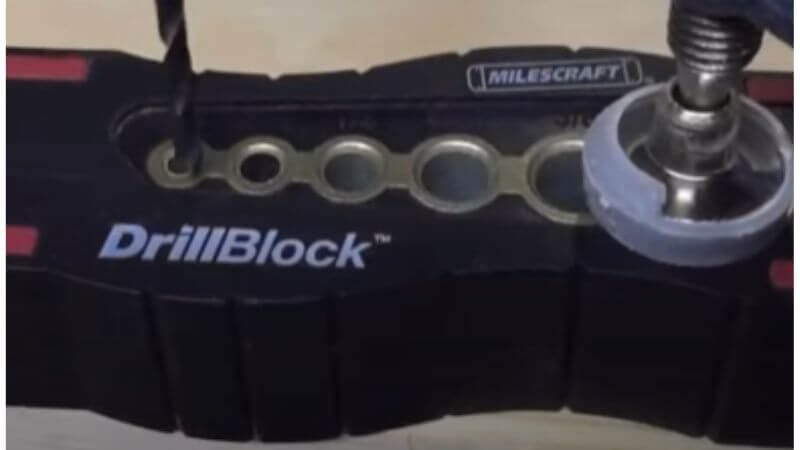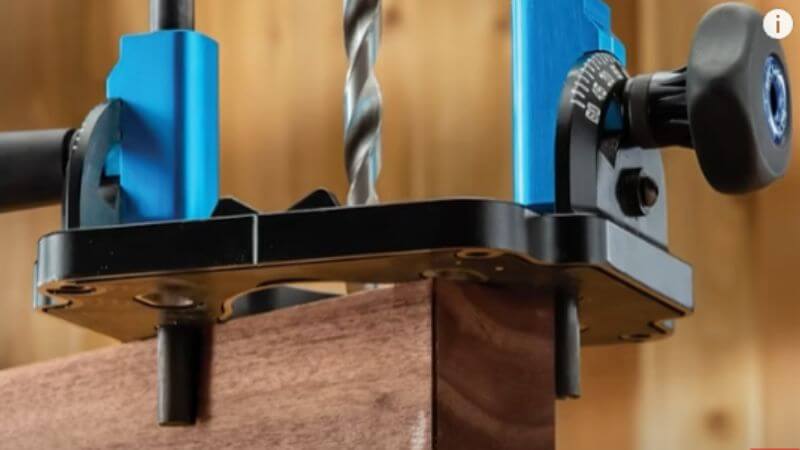If you’re looking for a guide on how to drill a straight hole without a drill press, you’ve come to the right place. In this blog post, we’ll be walking you through a step-by-step guide on how to do just that. We’ll also be giving you some helpful tips and tricks along the way, so be sure to read on.
Drilling a straight hole with a drill block
If you’re looking to drill a precise, straight hole, you may be wondering if a drill block can help you achieve that goal. While a drill block can be a helpful tool in creating straight holes, it’s important to keep a few things in mind in order to ensure success.
First, it’s important to select a drill block that is the same size or slightly larger than the drill bit you’ll be using. This will help to prevent the drill bit from wandering off course. Additionally, be sure to use a sharp drill bit – a dull bit is more likely to cause the drill to wander.
Choosing the right drill block
The material of the drill block should be considered. Different materials will require different types of drill bits and speeds. Second, the size of the hole to be drilled should be taken into account. Larger holes will require a larger drill block. Finally, the surface that the hole will be drilled into should be considered. Softer surfaces, such as wood, will require a different type of drill block than harder surfaces, such as metal.

Drilling a straight hole with a drill block in 5 steps
- First, secure your workpiece in a vise or other clamping device. This will ensure that it doesn’t move while you’re drilling.
- Next, position the drill block on the workpiece. Make sure that the block is positioned exactly where you want the hole to be drilled.
- Once the block is in place, use a center punch to mark the spot where the hole will be drilled. This will help prevent the drill bit from slipping.
- Apply pressure to the drill block, keeping the drill bit straight. Slowly start drilling the hole.
- As you drill, periodically check to make sure the hole is staying straight. If it starts to veer off course, stop and realign the drill bit.
Drilling a straight hole with a drill guide jig
What is a drill guide jig?
A drill guide jig is a tool that helps ensure precise, accurate drilling by providing a stable guide for the drill bit. By using a drill guide jig, you can avoid the potential for errors that can occur when hand-drilling, such as drift (the tendency of the drill bit to wander off course) or misalignment (drilling at an angle instead of perpendicular to the surface). Drill guide jigs are especially helpful when working with larger bits or when drilling multiple holes in a precise pattern.
How to drill a straight hole with a drill guide jig in 5 steps
- Choose the right drill bit for the job. Make sure it’s the correct size and type for the material you’re drilling into.
- Attach the drill guide jig to your work surface. Use clamps or another method to secure it in place.
- Then, using a drill bit that’s slightly smaller than the diameter of your desired hole, drill through the jig’s guiding path.
- Once the bit has emerged on the other side of the workpiece, remove the jig.
- Finish drilling the hole, using a drill bit that’s the same size as the one you used in Step 3.
Drilling a straight hole using a portable drill guide
What’s a portable drill guide?
A portable drill guide is a handheld device that helps you drill straight holes. It is especially helpful when you need to drill large holes or when you don’t have a drill press. A portable drill guide consists of a base, a guide rod, and a drill bit. The base is usually made of metal or plastic and has a set of jaws that clamp onto the workpiece. The guide rod is attached to the base and extends up through the center of the drill bit. The drill bit is held in place by a chuck that is connected to the guide rod.

How to drill a straight hole using a portable drill guide in 5 steps?
- Begin by clamping the drill guide onto the workpiece. It’s important to make sure that the guide is level and squarely positioned before proceeding.
- Next, use a sharp bit to drill a pilot hole through the center of the guide. This will help to ensure that the main hole is perfectly straight.
- Once the pilot hole has been drilled, remove the drill bit and insert the desired drill bit for the main hole.
- Next, set up your drill bit in the guide. Make sure the bit is properly secured before starting to drill.
- Once the bit is set up, start drilling slowly and evenly. Don’t apply too much pressure, or the drill may wander off course. Keep drilling until the bit breaks through the other side of the workpiece.
How to drill straight holes in the wall?
If you’re hanging shelves or mounting a TV, you’ll need to drill perfectly straight holes in the wall. Here’s how to do it:
- Use a spirit level to mark a horizontal line on the wall where you want to drill the holes.
- Measure the distance between the marks and transfer these measurements to the drill bit.
- Use a tape measure to find the center point of each mark and make a small pencil mark. This is where you’ll start drilling.
- Put the tip of the drill bit on the mark and drill straight into the wall. Keep the drill bit perpendicular to the wall to ensure a straight hole.
- Repeat this process for each hole.
How to drill straight holes in metal
To ensure your holes are drilled perfectly straight every time, follow these tips from the experts. First, use a sharp drill bit that is the correct size for the material you’re drilling. A dull bit will cause the drill to wander, making it difficult to keep the hole straight.
Next, secure the workpiece in a vise or clamp so it won’t move while you’re drilling. This will help prevent the drill bit from slipping and creating a crooked hole.
Finally, take your time and apply steady pressure to the drill as it penetrates the metal. A slow and steady motion will result in a straighter hole than if you try to drill too quickly.
FAQ
What are drill bushings used for?
Drill bushings are commonly used to protect workpieces from being damaged by drill bits. They also help to ensure that drill bits stay sharp for longer. Drill bushings can be made from a variety of materials, including metals, plastics, and composites.
What kind of jig to use for drilling straight holes in wood?
There are many different types of jigs that can be used for drilling straight holes in wood. The type of jig that you choose will depend on the specific project that you are working on. If you are working on a large project, you may want to consider using a drill press jig. This type of jig is designed to hold the drill bit in place so that you can drill straight holes without having to worry about the drill bit slipping.
Can you drill a straight hole in a pipe?
It is possible to drill a straight hole in a pipe, but it requires a few special considerations. First, the pipe must be properly secured in a vise or other holding device. Second, a sharp, high-quality drill bit must be used. Third, the drill bit must be the correct size for the pipe being drilled. Fourth, the drill bit must be lubricated with a cutting oil to prevent it from overheating. Finally, the drill bit must be turned slowly and steadily to avoid breaking the pipe.
Can you drill straight holes in concrete?
Drilling into concrete is a common DIY project, but it’s important to know whether or not your drill can handle the material. Many drills are not powerful enough to drill through concrete, so it’s important to check your drill’s specifications before beginning your project. If your drill is not powerful enough, you may be able to rent a more powerful one from a local hardware store.
Conclusion
Not everyone has time or money for a drill press, but that doesn’t mean you have to settle for crooked or off-center holes. Use the tips that I have mentioned here to drill straight holes at the bench or in the field.